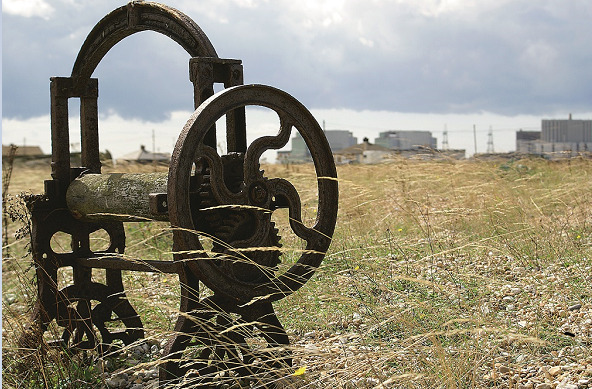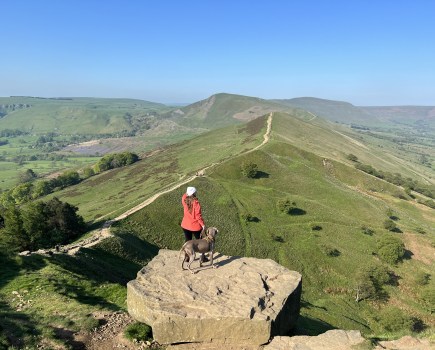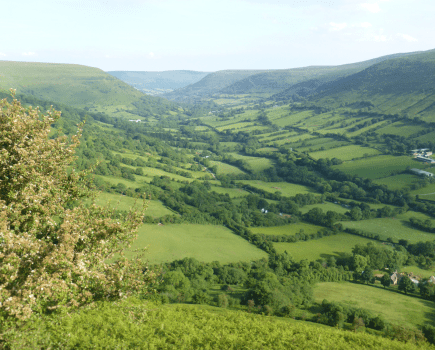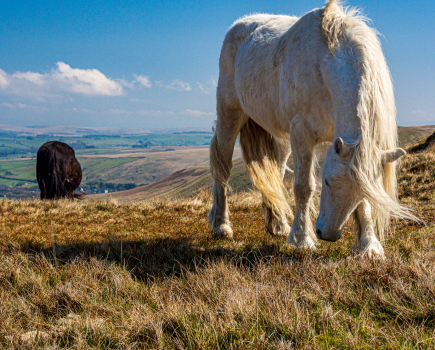It’s the end of the world as we know it, and Geoff Barton feels fine – as long as he has his camera in hand
I’m part walker, part photographer. Some days, it’s nice to walk without the camera – without surveying the landscape for the next shot, or calculating where and when the light will be at its best. I just try to take it all in, enjoy the moment, and let my mind wander. Some days, however, I walk with a more creative purpose: to fulfil a particular photographic brief, be it shots for The Great Outdoors, or a personal project. Today was one of the latter days.
The project in question is one to which I’ve returned more than any other since getting into photography seven years ago: photographing Dungeness, on the south coast of Kent. It’s an area that I hold a deep affection for, but also one which made me hesitate before putting forward as a Wild Walk for this magazine. Not a hill in sight, not much greenery, and, dominating everything, a ruddy great nuclear power station – not your usual The Great Outdoors fare, then. But there is a great beauty to this place, albeit somewhat unconventional. It’s a lot like walking through the post-apocalyptic future of science fiction. On a gloomy, grey day, the surroundings can be eerily reminiscent of the film adaptation of Cormac McCarthy’s novel, The Road.
For this walk, I decided to take in a sight that I hadn’t visited for some time – the Denge sound mirrors. These giant concrete monoliths were built in the 1920s and 30s as pre-radar early-detection devices of aircraft approaching over the English Channel. At the time, this technology was still experimental, and this is evidenced by the very different designs of the three ‘mirrors’ at Denge. From the viewing
point, the furthest away (and biggest) is a 200- foot long curved concrete wall, and resembles a miniature Hoover Dam. The nearer, smaller mirrors look like concrete satellite dishes, as if I’ve travelled forward into that sciencefiction future and am looking at the petrified remains of our once-global telecommunication technology. In fact, the mirrors were built to work in a manner not dissimilar to satellite dishes, with surfaces designed to reflect sound (not radio) waves to a point in front of the dish, where a carefully positioned microphone could be used to detect the engine noise of approaching aircraft. As it turned out, the development of radar made the mirrors obsolete almost as soon as they were built, and they’ve stood here unused ever since.
You can’t get right up to the mirrors, as they’re on an island in the Greatstone lakes, but the path I followed takes you along a spit of land, out into the lake and within about twenty metres of the nearest one. A steel swing bridge has been built to span the divide, although for most of the year it’s padlocked in place. Today was a windy day, but as I lent on the bridge and looked at the mirrors, I was struck by how quiet it was. Sheltered from the breeze, I stood and took in the silent presence of these ancient watchmen.
Back on the beach, I headed south towards Dungeness itself. I’ve described a route here which hugs the coast around the point, and then cuts in and follows the roads back north. In truth, though, the joy of this landscape is just wandering around, exploring the rusting huts, rotting boats and decaying buildings that seem to have just been dropped onto the surroundings. Although the area has evolved this way organically, it feels anything but natural, as if in the aftermath of some Hollywood style disaster. I keep expecting to look up and see smoke and flames pouring from the power station, or zombies shuffling into view from behind a hut. Perhaps I’ve just been watching too many episodes of The Walking Dead.
I eventually head back up the beach to where my car is parked, content with having filled a memory card on my camera with more shots of this unusual landscape and its detritus, and it occurs to me that no matter how many times I return, I never get bored with walking here, and always find something new to see. It may not be for everyone, but Dungeness, like my favourite science fiction films, repays repeat viewing.
ROUTE DESCRIPTION
- [1] Park in Lade car park on Coast Drive, opposite Taylor road. There are public toilets here and a boardwalk across the beach. Walk up Taylor Road, and where it bends to the left, head diagonally to the right, across the shingle towards the Greatstone lakes.
- [2] Take the path that runs alongside the lake. Follow it along the spit of land taking you out towards the island and the sound mirrors. The metal swing bridge is as close as you can get, although guided tours are available (see information, left).
- [3] Head back to the car park, and south along the beach. It’s pebbly, so the walking can be a bit slow-going.
- [4] The route shown follows the coast around the point, turning inland once you reach the power station. In reality, I tended to wander about a bit more randomly, before heading back up the beach. There’s plenty to see, but one thing to look out for is Prospect Cottage and garden [5], the former home of late film director Derek Jarman.
It’s the end of the world as we know it, and Geoff Barton feels fine – as long as he has his camera in hand
I’m part walker, part photographer. Some days, it’s nice to walk without the camera – without surveying the landscape for the next shot, or calculating where and when the light will be at its best. I just try to take it all in, enjoy the moment, and let my mind wander. Some days, however, I walk with a more creative purpose: to fulfil a particular photographic brief, be it shots for The Great Outdoors, or a personal project. Today was one of the latter days.
The project in question is one to which I’ve returned more than any other since getting into photography seven years ago: photographing Dungeness, on the south coast of Kent. It’s an area that I hold a deep affection for, but also one which made me hesitate before putting forward as a Wild Walk for this magazine. Not a hill in sight, not much greenery, and, dominating everything, a ruddy great nuclear power station – not your usual The Great Outdoors fare, then. But there is a great beauty to this place, albeit somewhat unconventional. It’s a lot like walking through the post-apocalyptic future of science fiction. On a gloomy, grey day, the surroundings can be eerily reminiscent of the film adaptation of Cormac McCarthy’s novel, The Road.
For this walk, I decided to take in a sight that I hadn’t visited for some time – the Denge sound mirrors. These giant concrete monoliths were built in the 1920s and 30s as pre-radar early-detection devices of aircraft approaching over the English Channel. At the time, this technology was still experimental, and this is evidenced by the very different designs of the three ‘mirrors’ at Denge. From the viewing
point, the furthest away (and biggest) is a 200- foot long curved concrete wall, and resembles a miniature Hoover Dam. The nearer, smaller mirrors look like concrete satellite dishes, as if I’ve travelled forward into that sciencefiction future and am looking at the petrified remains of our once-global telecommunication technology. In fact, the mirrors were built to work in a manner not dissimilar to satellite dishes, with surfaces designed to reflect sound (not radio) waves to a point in front of the dish, where a carefully positioned microphone could be used to detect the engine noise of approaching aircraft. As it turned out, the development of radar made the mirrors obsolete almost as soon as they were built, and they’ve stood here unused ever since.
You can’t get right up to the mirrors, as they’re on an island in the Greatstone lakes, but the path I followed takes you along a spit of land, out into the lake and within about twenty metres of the nearest one. A steel swing bridge has been built to span the divide, although for most of the year it’s padlocked in place. Today was a windy day, but as I lent on the bridge and looked at the mirrors, I was struck by how quiet it was. Sheltered from the breeze, I stood and took in the silent presence of these ancient watchmen.
Back on the beach, I headed south towards Dungeness itself. I’ve described a route here which hugs the coast around the point, and then cuts in and follows the roads back north. In truth, though, the joy of this landscape is just wandering around, exploring the rusting huts, rotting boats and decaying buildings that seem to have just been dropped onto the surroundings. Although the area has evolved this way organically, it feels anything but natural, as if in the aftermath of some Hollywood style disaster. I keep expecting to look up and see smoke and flames pouring from the power station, or zombies shuffling into view from behind a hut. Perhaps I’ve just been watching too many episodes of The Walking Dead.
I eventually head back up the beach to where my car is parked, content with having filled a memory card on my camera with more shots of this unusual landscape and its detritus, and it occurs to me that no matter how many times I return, I never get bored with walking here, and always find something new to see. It may not be for everyone, but Dungeness, like my favourite science fiction films, repays repeat viewing.
ROUTE DESCRIPTION
- [1] Park in Lade car park on Coast Drive, opposite Taylor road. There are public toilets here and a boardwalk across the beach. Walk up Taylor Road, and where it bends to the left, head diagonally to the right, across the shingle towards the Greatstone lakes.
- [2] Take the path that runs alongside the lake. Follow it along the spit of land taking you out towards the island and the sound mirrors. The metal swing bridge is as close as you can get, although guided tours are available (see information, left).
- [3] Head back to the car park, and south along the beach. It’s pebbly, so the walking can be a bit slow-going.
- [4] The route shown follows the coast around the point, turning inland once you reach the power station. In reality, I tended to wander about a bit more randomly, before heading back up the beach. There’s plenty to see, but one thing to look out for is Prospect Cottage and garden [5], the former home of late film director Derek Jarman.









